
Last modified: 2014-12-27 by pete loeser
Keywords: ufe | unidentified flags | 2013 |
Links: FOTW homepage |
search |
disclaimer and copyright |
write us |
mirrors
Please note our Policy for Submissions and Enquiries.
Below is a series of images of flags that have been provided to FOTW; some we have recognized, and some we have been unable to recognize. If you can help us identify any of these flags, please let us know! Contact the: UFE Editor.
Identification Key:
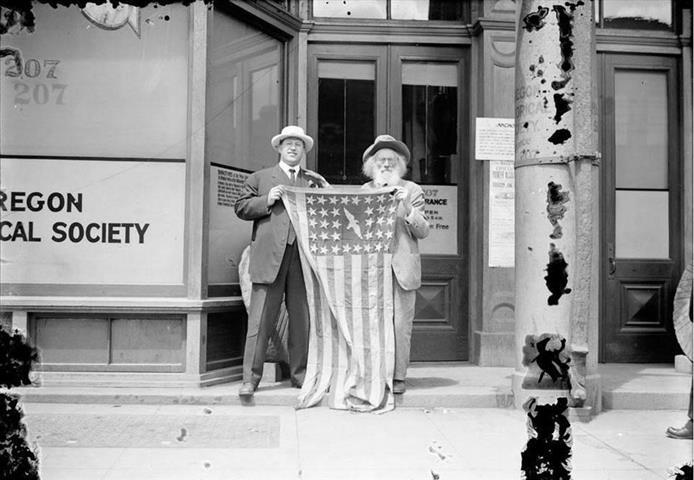

Image from Bishop Lamoureux, 22 August 2014
This picture was originally posted on Reddit. A Reddit editor posted this information about the picture. "The window and the pole say Oregon Historical Society. Oregon become a state in 1859, a few years before this flag was made. Based on the clothing the picture would be dated from about c1929. Thus the flag might have something to do with the 70th anniversary of Oregon's admission to the Union."
Another Reddit user surmised the following: "It has thirty four stars, so it would have to be an American/Union flag. The thirty fourth state to join the union was Kansas, so that might have some significance. The Union flag had thirty four stars from 1861-1863. This could have been a regimental flag."
Bishop Lamoureux, 22 August 2014
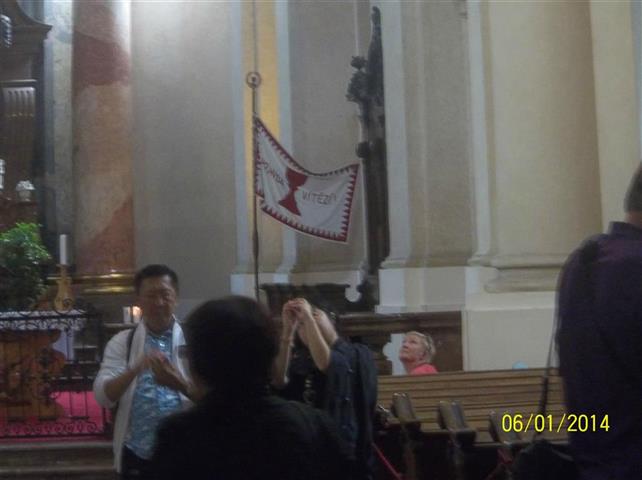
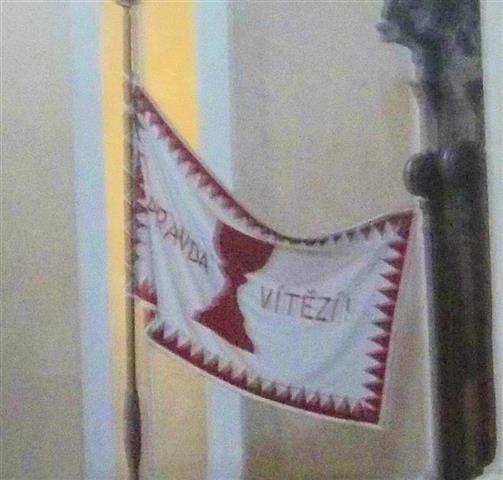
Images from Bishop Lamoureux, 22 August 2014
A description originally posted on Reddit: "I was in a Hussite Church in Prague and they had a pair of flags by the Alter. One was the flag of the Hussite Church in the Czech Republic, and the other was this one I have not been able to identify."
Bishop Lamoureux, 22 August 2014
The wording on either side of the red chalice on the flag is PRAVDA VITEZI, which is Slovenian for "THE KNIGHTS OF JUSTICE." There is a humanitarian aid organization called "The Sovereign Order of the Knights of Justice" that works with the United Nations. They provide aid to the poor and the sick, support schools in poor countries, and help children and the elderly people in Europe, Asia, Africa and America. The Sovereign Order of the Knights of Justice is divided into a number of so-called Grand Priories, Priories, Commanderies and Delegations. They are commanded by Grand Priors, Priors, Commanders and Delegates. One such division is the "Commandery of Czech Republic." I'm not sure they have a flag, but perhaps this is it.
Pete Loeser, 23 August 2014
Seems to be a good guess. As far as I know, the Hussites were divided into moderate Utraquists and radical Taborites (the latter were plundering Saxonia and parts of Brandenburg until they were defeated at Bernau). One of their religious targets, probably of both groups, was to celebrate the communion in both conformations (i.e. bread AND wine). The Catholics celebrated (and celebrate) it exclusively as bread. So a chalice might be an adequate symbol for Hussites.
Klaus-Michael Schneider, 23 August 2014
(Yes, I can see how Hussites would be a bit angry after the Catholics gave Jan Huss free passage, but burned him at the stake regardless.)
Considering that "pravda" means "truth", isn't it more likely to be the translation of "Veritas vincit", usually translated as "truth prevails"? It looks like the Hussite motto "Truth triumphs over all", is used in that shortened form by Czechia itself. Combined with the symbol of the chalice, that would suggest a Czechian Hussite flag.
Peter Hans van den Muijzenberg, 24 August 2014
The use of a chalice on a flag in Prague isn't surprising, the earliest evidence indicates that a "gonfaion" was used for a symbol of the Old Town of Prague as early as 1419, and a Hussite chalice was used on the Prague Banner in c1477. To quote my earlier self: "It was during the Hussite Wars the City of Prague was attacked by the "Crusaders" and mercenary forces, and the city militia fought back bravely under this Prague banner." It is not unexpected to find it also used as a symbol on this modern flag, whatever it may be.
Pete Loeser, 24 August 2014
 Image from Albert S. Kirsch, 30 June 2014
Image from Albert S. Kirsch, 30 June 2014
[This enquiry is a bit out of order, sorry I was asleep at the wheel - Ed.]
Does anyone recognize this pennant? It would appear to be a yacht club burgee; It was found with WW2 Japanese and German items.
Albert S. Kirsch, 30 June 2014
A tennis ball being something like 6.7 cm, this pennant would be approximately 25 cm. high. It might be slightly more because the apparent size of the pennant changes with the camera angle, while the ball's size doesn't.
As an aside: Don't connect your ropes that way, unless all four ends are secured. This is an open connection and it will over time move towards loose ends. That's why the well-known flag knot has two of the lines crossed, so there'll be tension to keep it in place.
It seems somewhat familiar, but I don't dare to say I've seen it before. I especially don't for all the flag knots I recall.
Peter Hans van den Muijzenberg, 24 August 2014
This flag has been positively identified as that of the Vale de Prazeres e Mata da Rainha Commune in Portugal.
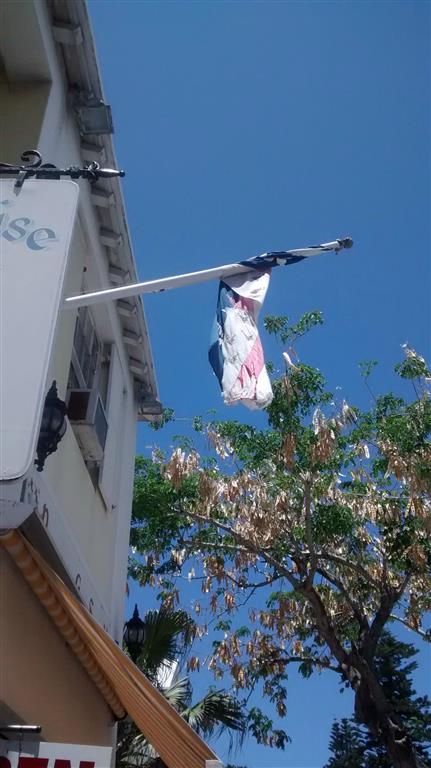
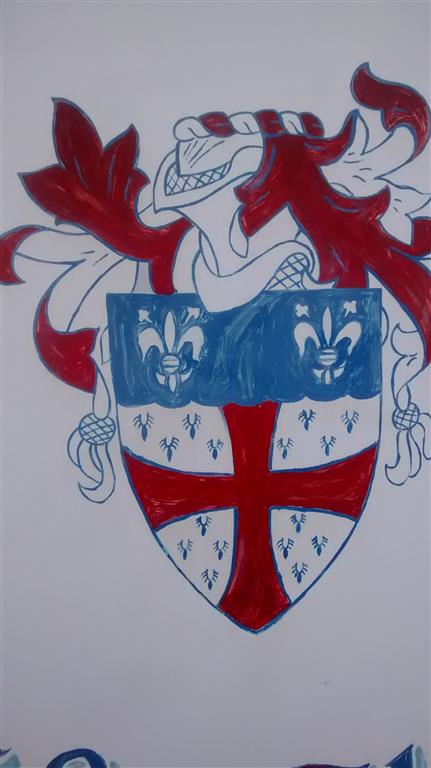

Images from Bishop Lamoureux, 4 September 2014
The original poster, Imnimo, said "I saw this flag flying outside a gift shop in St. George's, Bermuda. It's a bit hard to see because it's wrapped around the pole, but it looks like it's the same as the coat of arms painted on the side of the building. After a bunch of Googling, I haven´t been able to find it anywhere - is this just a random family crest in flag form, or is there more too this flag? As far as I can tell, it isn't the flag of any Bermuda municipality."
Bishop Lamoureux, 4 September 2014
 Image from Bishop Lamoureux, 4 September 2014
Image from Bishop Lamoureux, 4 September 2014
This was the description from wessideride: "Took this photo at a African refugee rally in Israel, could anyone identify the flag for me and give me some information?" Some reddit users posted these theories regarding the origins of the flag.
Bishop Lamoureux, 4 September 2014
I do not know what the flag represents, however I note that it is the Ogaden National Liberation Front flag (red, blue, green stripes) with an additional black stripe and the star enlarged and re-centred.
The ONLF (a separatist group in Eastern Ethiopia) was established in 1984 and diaspora communities are currently commemorating the 30th anniversary of the founding of ONLF on 30 August 1984. The current supporters of Ogaden liberation continue to use the ONLF flag.
The photo was taken at a World Refugee Day event on Tel Aviv in June 2013 for World Refugee Day. It appears to have been a rally of 200 Eritreans who were commemorating the martyrs in Eritrea's struggle for independence.
Ralph Kelly, 5 September 2014
Perhaps it is a new Somali Bantu flag?
Jaume Ollé, 6 September 2014
Could this be the new ONLF flag mentioned on our page "Ogaden (Ethiopia)", but not shown?
Pete Loeser, 6 September 2014
 Image from Ralph Kelly, 9 September 2014
Image from Ralph Kelly, 9 September 2014
I looked at several Ogaden websites and they are all still using the original Ogaden National Liberation Flag as the de-facto flag for Ogaden (called by some Ogadeniya). Tony Burton of Flags Australia recently helped some Ogaden people in Sydney to obtain hand-wavers of this flag for their 30th anniversary commemoration. Chrystian Kretowiicz on 5 Dec 2010 included this illustration of the ONLF flag. It has the ONLF emblem on a white over red bi-coloured flag. As you can see - it is not our UFE.
Ralph Kelly, 9 September 2014
In 2009, the OLF was divided in two factions: the OLF-QC (Oromo Liberation Front - Qaama Ceehumsa) and the OLF-SG (Oromo Liberation Front - Shanee Gumii), both using the same flag. In 2010, one of the factions created the Revolutionary Democratic Oromo Liberation Front (RDOLF). The white over red could be the unknown flag of RDOLF that in 7 March 2011, joined the ULFO. It is known that the OLF didn’t change its flags and the main faction is now using the R-V-R flag.
The ULFO was created in April 2010 by three movements:
1) The Front for Independent Democratic Oromiyaa (FIDO) / R-V-R flag with central emblem
2) The United Oromo People’s Liberation Front (UOPLF) / N-R-W flag with central emblem
3) The Council of Oromiyaa People’s Liberation Front (COPLF) - Gumii adda bilisimmaa ummata / N-R-W flag
The flag of ULFO is the N-R-W version. The RDOLF flag is not known to me. The image from Christyan could be, in fact, a partial image lacking the black upper stripe, rather than a accurate image of the RDOLF flag. Many of the Oromo groups use the N-R-W colors with their own emblem, or variants of this arrangement. An extensive article about flags of Africa, Gambella, Harar, Oromia and Ogadenia will be published in Flag Report 72 that will be distributed in October 2014.
Jaume Ollé, 9 September 2014
 Image from M. Schmöger, 6 September 2014
Image from M. Schmöger, 6 September 2014
On the Italian Ebay one can buy a collector´s card with a strange design for a flag of Botswana (Beciuania), namely a green-white-black vertical triband. Is this purely fictitious or an early design?
M. Schmöger, 6 September 2014
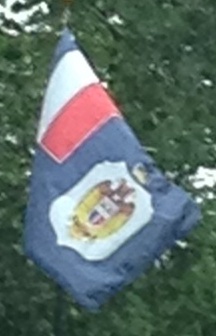 Image from Tom Cseh, 9 September 2014
Image from Tom Cseh, 9 September 2014
Any idea who this particular flag with what appears to be the French tricolor in the upper hoist might belong to?
Tom Cseh, 9 September 2014
I have never seen it before, but if the photo was taken in Mexico, it might date back to the occupation of this country by the French army (along with British, Spanish and even Belgian troops, but only the French stayed there for a while) in the XIXth Century. I don't think the French army had enough time to establish a local administration.
Corentin Chamboredon, 10 September 2014
Way outside my area, but could this flag have anything to do with the period in which the Emperor Maximilian ruled the country with French support? Is three years long enough to establish an administration which would require a flag.
Christopher Southworth, 10 September 2014
The flag does not have the coat-of-arms used during the Second Mexican Empire of Maximilian I, but the shield on this flag has a double-headed eagle and may have a connection with Maximilian's Austrian or Holy Roman ancestors, perhaps Austrian troops sent in support of the French claim? Notice the similarities to the Austro-Hungarian coat-of-arms. Examples at Austro-Hungarian Empire: Imperial Standards and Austro-Hungarian Empire: Military Flags.
Pete Loeser, 10 September 2014
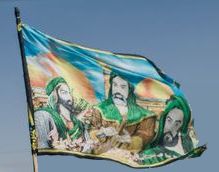 Image from Esteban Rivera, 13 September 2014
Image from Esteban Rivera, 13 September 2014
[image cropped by UFE Editor]
An article in the online version of the New York Times on September 11, included a picture of a flag of an anti-ISIS group seen during the siege of Amirli. The picture (seen here in its entirety) has a caption that reads "Shiite militias last week after helping free the town of Amerli in northern Iraq from an ISIS siege". The main article deals with the "strange" and rather "odd" alliances that this group (ISIS) has brought together against it.
The flag shows three men, most likely important figures in Islamic religion, maybe prophets or Imam´s, since they seem to be holding books, scriptures and all sorts of sacred items.
Since there were so many belligerents in this particular battle making up the informal coalition of ground forces battling against ISIS, plus Ameril (Amirli) being predominantly populated by Turkmen, it indicates that this flag is of Turkmen origin. Members of the coalition included the Iraqi Turkmen Front and various Special Groups (a term used by the US to identify Iran-backed Shia paramilitaries in Iraq), including the Promised Day Brigades, the Asa'ib Ahl al-Haq, the Kata'ib Hezbollah, the Badr Brigades, and the Peshmerga, who are the armed forces of the Kurdistan Regional Government semi-autonomous Region.
Esteban Rivera, 13 September 2014
 Image from Esteban Rivera, 15 November 2014
Image from Esteban Rivera, 15 November 2014
I found information on this group Arab Revolutionary Brigades on the Tracking Terrorism website and in this entry, they show this flag which displays another religious figure, very similar to one of the faces displayed on UFE 14-64. Maybe it is a common thing to display faces of important religious figures in rebel groups' flags (against current Assad regime and against Isis as well), although I'm not certain of what they mean nor who it is.
Esteban Rivera, 15 November 2014
If I'm not mistaken, portraiture is only used by Shia, not by Sunni.
Al Kirsch, 15 November 2014
This has been identified as a World War II era US Army Transportation Corps Flag.
 Image from Esteban Rivera, 23 September 2014
Image from Esteban Rivera, 23 September 2014
Two days ago, on September 21, the Spanish newspaper El País published an article on recent pro-Ukraine protests in Moscow. In this article one can see this orange UFE. The very next day, on September 22, Qatar-based news outlet Al-jazeera published another article on the same topic, featuring the same image with the same orange UFE. Does anybody know what this flag stands for?
Esteban Rivera, 23 September 2014
 Image from Victor Lomantsov, 23 September 2014
Image from Victor Lomantsov, 23 September 2014
This is not an Ukrainian flag, but rather the flag of the United Democratic Movement "Solidarnost" (Solidarity). Founded in 2008, one of co-chairmans is world chess champion Garry Kasparov. They use orange flags with black or white logo, white flags with orange logo etc.
Victor Lomantsov, 23 September 2014
Yes. You can find more information about this movement on Wikipedia.
Zoltan Horvath, 24 September 2014
Is this a separate organisation from the Ukrainian "Solidarity" (old name for the Petro Poroshenko bloc)?
Andrew Weeks, 24 September 2014
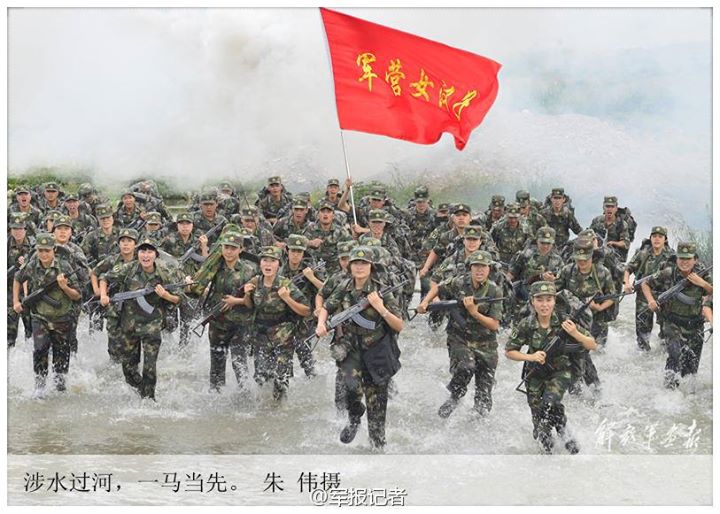 Image from Esteban Rivera, 30 September 2014
Image from Esteban Rivera, 30 September 2014
Can you help me identify this flag? It is a red horizontal flag with yellow inscription in (what seems to be) Mandarin.
Esteban Rivera, 30 September 2014
It reads "She-heroes of the barracks".
Miles Li, 30 September 2014
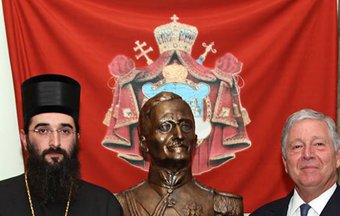 #68a
#68a
 #68b
#68b
Images from Barekhda Ayt, 12 October 2014
I found this photos of an event held in Russian cultural center in Belgrade two days ago. The gray haired person standing besides the bishop is HRH Prince Alexander Karageorgevich. The flag (#68a), however, hanging on the wall behind them is unknown to me. It resembles the flag of the patriarch of Serbian Orthodox Church. It has full coat of arms of SOC but placed on dark red field instead of Serbian tricolore with a white border with interlaced series of blue and red triangles. The flag is placed on the most prominent place during that event although the patriarch was not even present (hence the presence of the Bishop-vicarious Arsenios). Do you have any information about this flag?"
Also, on today's practice for military parade in honour of Liberation day of Belgrade, at which President of Russian Federation Putin will be present, the river flotilla was using another flag (#68b). By it's position it should be a military navy jack - Vojnopomorska pramcana zastava. However, I couldn't find any confirmation and hope you'll be able to identify it.
Dejan Ambrozic, 12 October 2014
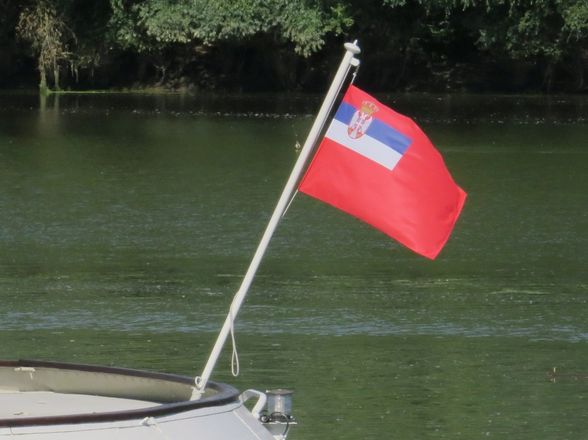 #68c
#68c
Image from Željko Heimer, 13 October 2014
From what I am aware, #68a is not any flag with any official status, simply an ornamentation on textile. It it hard to tell from the photo, but the item may not have even been intended to be displayed as a flag.
I have noticed that Serbian military ships tend to use in recent years various flags from the International Sygnal Code during the excercises and events - which I assume they are tactical signals specific for the excercise.
Anyway, the flag (#68a) is used as naval jack, as is this one (#68c) I posted on June 2010. However, I was unable to find any further info on this flag. The emblem is not that of the River Flotilla (which uses a simple per fess wavy gules-azure shield with white anchor) nor it is prescribed in any legislation or regulation that I have found so far...
Then again - I haven't found any legislation/regulation on the naval ensign as used at least since 2007 (probably with minor corrections to the COA style introduced in 2010). I am afraid that I was not being much of help.
Željko Heimer, 13 October 2014
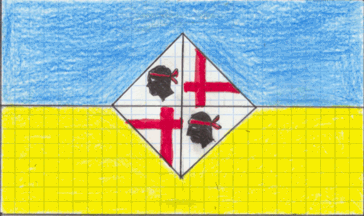 Image from Santiago Díaz, 21 October 2014
Image from Santiago Díaz, 21 October 2014
I saw this flag during an independentist demonstration in Barcelona last Sunday. It looked like an Ucranian flag, but with a obviously Catalan shield in the middle. I think it also had a crown over it. Might it be a municipal flag?
Santiago Díaz, 21 October 2014

This Saudi Arabian flag has now been identified as a "Variant of the Civil Flag" and moved to its permanent location.
This flag is now located on the FOTW database as the Brotherhood of the Holy Sepulcher in Jerusalem.
 Image from James Dignan, 1 November 2014
Image from James Dignan, 1 November 2014
I'm currently watching a football match on TV, live from Perth, Western Australia. Someone in the crowd is waving an interesting flag which looks like it may be an alternative design for a flag for Western Australia - anyone know anything about it? It's a red cross, fimbriated white, on a dark blue (or possibly black) background, with the state emblem of a black swan on a yellow disc in the centre.
James Dignan, 1 November 2014
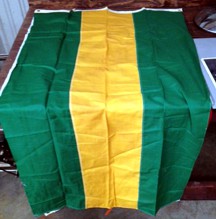 #73a
#73a
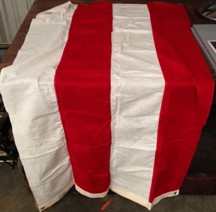 # 73b [may be reversed]
# 73b [may be reversed]
Image from Martin Dix, 29 October 2014
I have these two flags, both say RN 32335 and 100 percent cotton. Could you give me any information on these flags. I was going to hang them in my garage, but if they were too nice to do that, then I would preserve them another way
Jack Doyle
I am not sure what these flags are - at first I was going to say they look like decorative bunting, perhaps Brazilian and American, but then I noticed they had grommets so were meant to be hung like a flag, not draped decoratively.
Rob Raeside, 3 November 2014
 Image from Mark Rosenberg, 13 November 2014
Image from Mark Rosenberg, 13 November 2014
I viewed your extensive site and found flags similar, but with white stars instead of gold. This came from the estate of a Vietnam fighter pilot whose father, Brig. Gen. Glen C. Jamison flew in WWII. Any idea about the color and placement of the stars on this one? My understanding is the Gold Star represents a KIA, but Brig. Gen. Jamison lived until 1973.
Mark Rosenberg, 13 November 2014
Here is a link to Brig. Gen. Glen C. Jamison's service history.
Mark Rosenberg, 13 November 2014
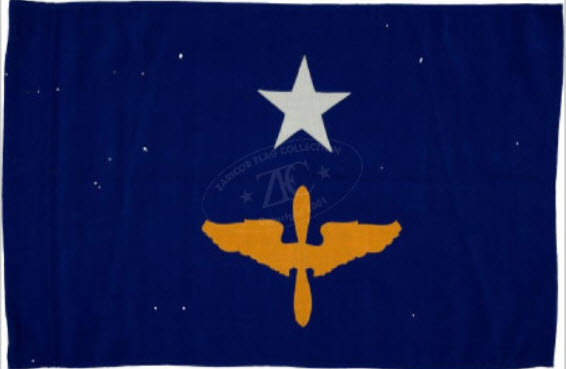 Image from Zaricor Flag Collection 13 November 2014
Image from Zaricor Flag Collection 13 November 2014
To add the two Euro cents I'm capable of contributing: I'd say that's indeed the officer's rank indicated. The Zaricor Flag Collection has, a U.S. Army Brigadier General Air Corps Flag, which has its charges in the same positions. Likewise the Army Brigadier General flag.
I think it's that emblem which would represent the Air Corps, while this one is actually for the Air Force, but I'll leave that to someone who understands American army. Anyway, the flags do seem to come in the same combinations of ranks and designs for the two, so US Air Force Brigadier General would seem to fit.
Peter Hans van den Muijzenberg, 13 November 2014
The winged star emblem (the 'Hap Arnold' wings) indicated this as the flag of a brigadier-general of the US Army Air Forces during World War II (as opposed to that of the pre-war US Army Air Corps which used a winged propeller emblem instead). As for the yellow star - maybe it was a manufacturer's mistake, or maybe it was a white star which got 'yellowed' as the flag aged... I cannot say for sure.
Miles Li, 15 November 2014
Just a completely off-the-wall question here, but is it possible that the USAAF rank flag with the gold star is actually intended to represent a brigadier general killed in action? The traditional white star would be replaced with a gold star similar to the blue stars being replaced with gold stars on Service Banners. Possible?
Randy Young, 30 November 2014
 #75a
#75a
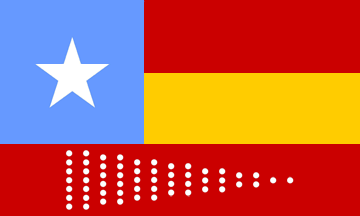 #75b
#75b
Image from Clay Moss, 14 November 2014
These are images drawn from illustrations sent to me by a merchant marine buddy. I'm after more details. Meanwhile, does anyone recognize them?
Clay Moss, 14 November 2014
This flag have been identified as a version of the Anonymous Organization Medic Flag backed by an Anonymous Organization flag.
These flags were identified as vexi-vaporware versions of Anonymous Organization Flags of the Anonymous State of Massachusetts and Anonymous Iceland.
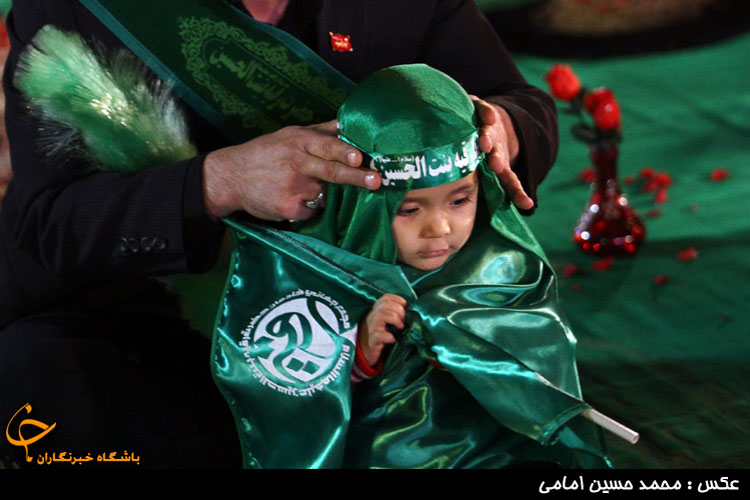 Image from Esteban Rivera, 30 November 2014
Image from Esteban Rivera, 30 November 2014
I've found this Iranian UFE from this picture taken on 1393-7-9 (Persian calendar) which belongs to this picture gallery. When I translate it, the following title comes: "World Assembly of Clerks Roqiyeh (R) Bint Al Hussein" Does anybodoy know if it's indeed a flag and what it stands for?
Esteban Rivera, 30 November 2014
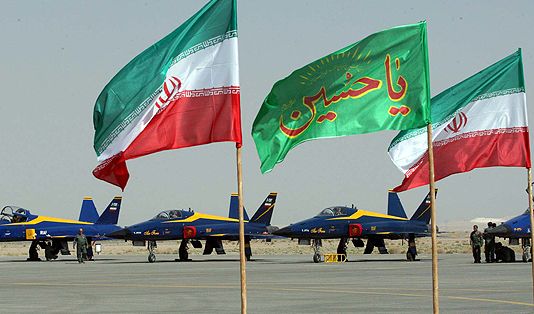 Image from Esteban Rivera, 30 November 2014
Image from Esteban Rivera, 30 November 2014
In this picture
from this source taken back in 2010, the green flag in the middle with red lettering is unidentified. Could it possibly be government related?
Esteban Rivera, 30 November 2014
It reads as "Ya Hussein", but I have no idea what it does mean.
Zoltan Horvath, 30 November 2014
May be something to do with "Ya Hussain"
Dirk Schönberger, 30 November 2014
It seems to be a religious prayer: "Ya Hussain is an Arabic phrase used by Shia Muslims to invoke the memory or intervention of Hussain ibn Ali. It is especially used in the context of the Mourning of Muharram."
I've also seen the following variants: Black background with red letters on Brian J. McMorrow Galleries and
White background with red letters on Ya Hussain Flag.
The explanation of the Iran Islam Shia Ya Husain Religious, Political and Military Flag is as follows: The inscript on the flag reads YA HUSAIN. He was the 3rd Imam of all Shia who was martyred in Karbala, Iraq, centuries ago and is a symbol for all Shias to raise against the Oppressors. The wording above YA HUSAIN is the Famous Hadith of Prophet Muhammad that reads: INNA-HUSAIN mISBAHUL-HUDA WA SAFINATUN-NAJAT that means "Husain is the Lighthouse of Islamic Guidance for the lost ships and the Rescue ship." Such flags are mostly used by Shia Political & Military Groups in Iran and Lebanon."
Source: Mecollectibles.com.
Esteban Rivera, 30 November 2014
Not quite sure if it is a religious phrase. Mourning of Muharram was the day Hussain was murdered (some kind of genesis story of Shiite vs. Sunnite muslims). Basically it means something like "Remember Hussein" (and forever don't be friend with his murderers). The event marks the anniversary of the Battle of Karbala when Imam Hussein ibn Ali, the grandson of the Prophet Muhammad, and a Shia Imam, was killed by the forces of the second Umayyad caliph Yazid I at Karbala. Source: wikipedia "Mourning of Muharram".
Dirk Schönberger, 30 November 2014
 Image from Esteban Rivera, 30 November 2014
Image from Esteban Rivera, 30 November 2014
Can anybody identify this flag from this source. When I translate it it says "Vice President of Science and Technolgy".
Esteban Rivera, 30 November 2014
 Speculative image from Zoltan Horvath, 7 December 2014
Speculative image from Zoltan Horvath, 7 December 2014
I created its flag image. The upper inscription is "Presidency of the Republic" and the lower one means: "Vice [Presidency] for Science, Technology and Innovation". I think it's definitely not a rank flag but an organizational one.
Zoltan Horvath, 7 December 2014
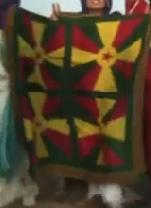 #81a
#81a
 #81b
#81b
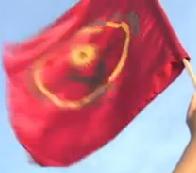 #81c
#81c
 #81d
#81d
Images from Esteban Rivera, 3 December 2014
On this al Jazeera's news report broadcasted today you can see a flag with several symbols of being Kurdish (if not supportive of a particular group, i.e. PKK, or the Kurdish Regional Government).
- Image #81a - a square flag, split into four equal areas where a red five-pointed star in the middle, with other colors related to Kurdish symbols (yellow and green), as seen on 1:27.
- Image #81b - a horizontal red flag, , with other colors related to Kurdish symbols (yellow and green), as seen on 1:29 onwards.
- Image #81c - a horizontal red flag, with other colors related to Kurdish symbols (yellow and green), as seen on 1:29 onwards.
- Image #81d - a horizontal red flag, , with other colors related to Kurdish symbols (yellow and green), as seen on 1:29 onwards.
I guess the second flag (#81b) is probably (and most likely) that of the Kurdistan Freedom Falcons.
"The Kurdistan Freedom Falcons (Teyrêęnbazê Azadiya Kurdistan, TAK), also known as the Kurdistan Freedom Hawks, is a militant group that has committed attacks throughout Turkey, operating in southeastern Turkey and northern Iraq with a goal of securing Kurdish secession from Turkey. It is unclear whether or not TAK is connected to any other Kurdish nationalist organizations, though it is believed they split off from the Kurdistan Workers Party (PKK) when they became dissatisfied with the group's tactics. The group was established on July 29, 2004. The group goes by other names including, but not limited to Kurdish Vengeance Brigade, Kurdistan Freedom Falcons Organization,Kurdistan Liberation Hawks."
Its flag is a red horizontal flag, with the logo in the middle, having the five-pointed red star inside a yellow sun, with the name Teyrênbazê Azadiya Kurdistan (in Turk) in green letters.
Esteban Rivera, 3 December 2014